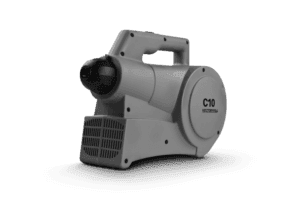Enhancing Poultry Farm Biosecurity with ULV Fogging Amid Avian Influenza
 ULV fogging involves the generation of fine mist particles containing disinfectants, which are dispersed throughout poultry housing facilities. This method ensures that disinfectant reaches all surfaces, including crevices and other hard-to-reach areas, providing thorough decontamination. The effectiveness of ULV fogging in inactivating avian influenza viruses has been supported by scientific studies, highlighting its role in reducing viral loads in poultry environments.
ULV fogging involves the generation of fine mist particles containing disinfectants, which are dispersed throughout poultry housing facilities. This method ensures that disinfectant reaches all surfaces, including crevices and other hard-to-reach areas, providing thorough decontamination. The effectiveness of ULV fogging in inactivating avian influenza viruses has been supported by scientific studies, highlighting its role in reducing viral loads in poultry environments.
Benefits of ULV Fogging in Poultry Farms
-
Comprehensive Disinfection: The fine mist produced by ULV foggers ensures uniform application of disinfectants, effectively targeting both surface and airborne pathogens.
-
Enhanced Biosecurity: Regular use of ULV fogging as part of a biosecurity protocol can significantly reduce the risk of avian influenza outbreaks, safeguarding poultry health and farm productivity.
-
Operational Efficiency: ULV foggers are designed for ease of use, allowing for rapid disinfection of large areas with minimal labor, thereby reducing downtime and operational disruptions.
Implementing ULV Fogging in Your Biosecurity Plan
Selecting Effective Disinfectants
Choosing the right disinfectant is crucial. The U.S. Environmental Protection Agency (EPA) maintains a list of antimicrobial products registered for use against avian influenza viruses on hard, non-porous surfaces. These products are specifically labeled to inactivate avian influenza A viruses and are commonly used in poultry facilities. epa.gov
Scientific studies have evaluated various disinfectants for their efficacy against avian influenza viruses. For instance, research published in the Indian Journal of Animal Research assessed four common disinfectants—deciquam solution, glutaral and benzalkonium bromide solution, sodium dichloroisocyanurate powder, and peroxyacetic acid solution. The study found that specific concentrations and contact times effectively inactivated the H7N9 subtype of avian influenza virus. arccjournals.com

Establishing a Regular Fogging Schedule
Consistency in disinfection practices is key to preventing viral spread. The California Department of Food and Agriculture emphasizes that cleaning and disinfection should be integral components of a biosecurity plan, especially during outbreaks. Regular application of EPA-registered disinfectants via ULV fogging can significantly reduce the presence of avian influenza viruses in poultry environments. cdfa.ca.gov
Training Personnel in ULV Fogging Procedures
Proper training ensures the effective and safe use of ULV fogging equipment. The U.S. Department of Agriculture’s Animal and Plant Health Inspection Service highlights the importance of thorough cleaning and disinfection protocols, noting that organic material must be removed prior to disinfection to ensure efficacy. Personnel should be trained to remove debris before applying disinfectants and to ensure that the disinfectant penetrates all areas, including porous materials. aphis.usda.gov
To enhance your biosecurity measures against avian influenza, consider incorporating ULV fogging technology. For more information or assistance, please contact us at:
Phone: +1-609-832-3640
Email: info@vectorfog.com
Our team is ready to support you in implementing effective disinfection protocols to protect your poultry farm.